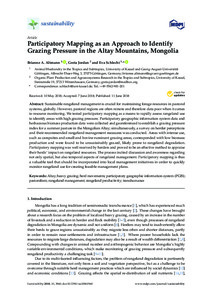Aufsatz
Artikel (Publikationen im Open Access gefördert durch die UB)

Participatory Mapping as an Approach to Identify Grazing Pressure in the Altay Mountains, Mongolia
Zusammenfassung
Sustainable rangeland management is crucial for maintaining forage resources in pastoral systems, globally. However, pastoral regions are often remote and therefore data poor when it comes to resource monitoring. We tested participatory mapping as a means to rapidly assess rangeland use to identify areas with high grazing pressure. Participatory geographic information system data and herbaceous biomass production data were collected and georeferenced to establish a grazing pressure index for a summer pasture in the Mongolian Altay; simultaneously, a survey on herder perceptions and their recommended rangeland management measures was conducted. Areas with intense use, such as campsites and small and bovine ruminant grazing areas, corresponded with low biomass production and were found to be unsustainably grazed, likely prone to rangeland degradation. Participatory mapping was well received by herders and proved to be an effective method to appraise their herds’ impact on rangeland resources. The process incited discussion and awareness regarding not only spatial, but also temporal aspects of rangeland management. Participatory mapping is thus a valuable tool that should be incorporated into local management initiatives in order to quickly monitor rangeland use for creating feasible management plans.
Zitierform
In: Sustainability. - Basel : MDPI. - 2018, 10 (6), 1960, 1-15Förderhinweis
Gefördert durch den Publikationsfonds der Universität KasselSammlung(en)
Publikationen (Fachgebiet Animal Husbandry in the Tropics and Subtropics)Artikel (Publikationen im Open Access gefördert durch die UB)
Zitieren
@article{urn:nbn:de:hebis:34-2018081756065,
author={Altmann, Brianne A. and Jordan, Greta and Schlecht, Eva},
title={Participatory Mapping as an Approach to Identify Grazing Pressure in the Altay Mountains, Mongolia},
year={2018}
}
0500 Oax 0501 Text $btxt$2rdacontent 0502 Computermedien $bc$2rdacarrier 1100 2018$n2018 1500 1/eng 2050 ##0##urn:nbn:de:hebis:34-2018081756065 3000 Altmann, Brianne A. 3010 Jordan, Greta 3010 Schlecht, Eva 4000 Participatory Mapping as an Approach to Identify Grazing Pressure in the Altay Mountains, Mongolia / Altmann, Brianne A. 4030 4060 Online-Ressource 4085 ##0##=u http://nbn-resolving.de/urn:nbn:de:hebis:34-2018081756065=x R 4204 \$dAufsatz 4170 7136 ##0##urn:nbn:de:hebis:34-2018081756065
<resource xsi:schemaLocation="http://datacite.org/schema/kernel-2.2 http://schema.datacite.org/meta/kernel-2.2/metadata.xsd"> 2018-08-17T14:00:09Z 2018-08-17T14:00:09Z 2018-06-11 2071-1050 urn:nbn:de:hebis:34-2018081756065 http://hdl.handle.net/123456789/2018081756065 Gefördert durch den Publikationsfonds der Universität Kassel eng Urheberrechtlich geschützt https://rightsstatements.org/page/InC/1.0/ Altay heavy grazing herd movements participatory geographic information system (PGIS) pastoralism rangeland management rangeland productivity transhumance 630 Participatory Mapping as an Approach to Identify Grazing Pressure in the Altay Mountains, Mongolia Aufsatz Sustainable rangeland management is crucial for maintaining forage resources in pastoral systems, globally. However, pastoral regions are often remote and therefore data poor when it comes to resource monitoring. We tested participatory mapping as a means to rapidly assess rangeland use to identify areas with high grazing pressure. Participatory geographic information system data and herbaceous biomass production data were collected and georeferenced to establish a grazing pressure index for a summer pasture in the Mongolian Altay; simultaneously, a survey on herder perceptions and their recommended rangeland management measures was conducted. Areas with intense use, such as campsites and small and bovine ruminant grazing areas, corresponded with low biomass production and were found to be unsustainably grazed, likely prone to rangeland degradation. Participatory mapping was well received by herders and proved to be an effective method to appraise their herds’ impact on rangeland resources. The process incited discussion and awareness regarding not only spatial, but also temporal aspects of rangeland management. Participatory mapping is thus a valuable tool that should be incorporated into local management initiatives in order to quickly monitor rangeland use for creating feasible management plans. open access In: Sustainability. - Basel : MDPI. - 2018, 10 (6), 1960, 1-15 Altmann, Brianne A. Jordan, Greta Schlecht, Eva doi:10.3390/su10061960 </resource>
Die folgenden Lizenzbestimmungen sind mit dieser Ressource verbunden:
Urheberrechtlich geschützt

